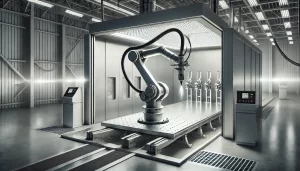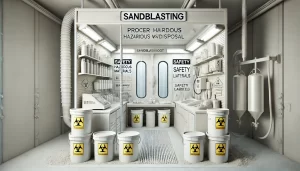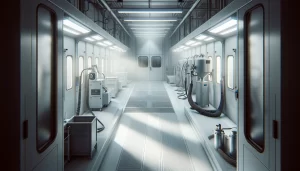When it comes to running a sandblasting operation, efficiency and quality are everything. Whether you’re using sandblasting for surface preparation, cleaning, or finishing, the media and filters play a critical role in getting the job done right. But like any consumable material, both media and filters wear out over time. Knowing when to replace them is key to maintaining peak performance, reducing costs, and ensuring a safe working environment.
Understanding the Role of Sandblasting Media
Sandblasting media is the material used to remove rust, paint, or other coatings from a surface. Different types of media, such as aluminum oxide, glass beads, garnet, and steel grit, offer different levels of abrasiveness and durability. Some media are reusable, while others break down quickly after a few uses. The frequency of replacement depends on factors such as the type of media, the material being blasted, and the intensity of the blasting process.
For instance, softer media like walnut shells or plastic beads wear down faster, meaning they need to be replaced more frequently. On the other hand, hard and angular materials like aluminum oxide or steel grit can be reused multiple times before they lose their effectiveness. If you notice that the media is breaking down into dust or no longer producing the same level of abrasion, it’s time for a replacement.
Over time, blasting media can accumulate dust, debris, and particles from the blasted surface. If the media is too contaminated, it can lead to inconsistent blasting results, clogging in the equipment, or even damage to delicate surfaces. Regularly checking for contamination and running media through a reclaiming system (if applicable) can extend its lifespan. However, once contamination reaches a point where it affects performance, it’s best to replace the media entirely.
How Filters Affect Sandblasting Performance
Just as media plays a crucial role in surface preparation, filters are essential for maintaining air quality and protecting equipment. Sandblasting produces a significant amount of dust, which can be hazardous to workers and damaging to machinery. Filters, including dust collector filters and air compressor filters, help remove airborne particles and keep the workspace safe.
Dust collector filters trap fine particles that are released during blasting, preventing them from spreading throughout the facility. Over time, these filters become clogged with debris, reducing their efficiency. If filters are not changed regularly, the system has to work harder to pull air through, leading to higher energy costs and decreased performance.
Similarly, air compressor filters remove moisture, oil, and contaminants from the compressed air used in blasting. If these filters are not maintained, moisture buildup can lead to rust in the equipment, affecting the quality of the blasted surface. Dirty filters also put more strain on compressors, shortening their lifespan and increasing maintenance costs.
Signs That It’s Time for a Replacement
While there is no one-size-fits-all answer to how often sandblasting media and filters should be replaced, there are some clear signs to watch for.
If you’re experiencing uneven blasting results, excessive dust, or clogging in your system, your media may be too worn or contaminated. Pay attention to how quickly the surface is being cleaned or prepped—if it takes longer than usual, your media may have lost its cutting ability.
With filters, a noticeable drop in airflow, excessive dust accumulation in the workspace, or increased energy consumption are all indicators that a replacement is due. Some dust collectors have pressure gauges that signal when filters are clogged; monitoring these readings can help you determine the right time for a change.
Establishing a Routine Maintenance Schedule
Rather than waiting for problems to arise, it’s best to have a proactive approach to maintenance. Establishing a regular schedule for inspecting and replacing sandblasting media and filters can prevent downtime and costly repairs.
For media, check its condition after each use and remove excessive debris. If you’re using a reclaim system, make sure it’s functioning properly to separate reusable media from waste. High-wear applications may require media changes multiple times a day, while lower-intensity operations may allow for longer use.
Filters should be checked at least once a week for visible dirt buildup. For high-production environments, replacing dust collector filters every few months ensures optimal performance. Air compressor filters may need to be changed every few hundred operating hours, depending on the manufacturer’s recommendations. Keeping spare filters on hand can help prevent delays when replacements are needed.
Maximizing Efficiency and Cost Savings
By replacing sandblasting media and filters at the right time, you can maximize efficiency and reduce costs. Worn-out media results in longer blasting times and inconsistent finishes, which means using more labor and energy. Similarly, clogged filters reduce airflow and increase energy consumption, driving up operational expenses.
Investing in high-quality media and filters can also make a difference. Cheaper media may break down faster, requiring more frequent replacements, while premium materials last longer and deliver more consistent results. Proper storage of media in dry conditions and regular maintenance of dust collection systems further extend the lifespan of both media and filters.
Specialized Sandblasting Booth Services
We specialize in providing top-quality sandblasting booths and custom finishing solutions tailored to meet the unique needs of various industries. Our expert team designs and manufactures state-of-the-art sandblasting booths that ensure safety, efficiency, and superior performance. From automotive and aerospace to marine and industrial applications, our booths are engineered to handle even the most demanding surface preparation tasks. We offer comprehensive services, including booth installation, maintenance, upgrades, and technical support.




